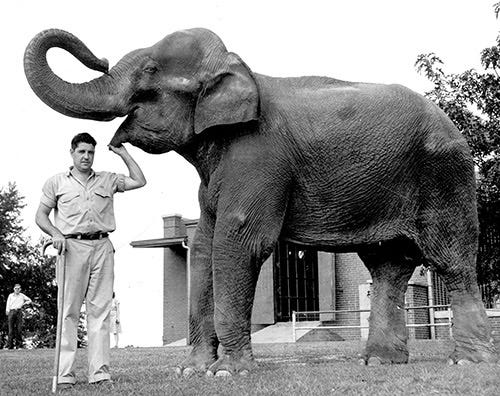When I handed my grandson a little stuffed elephant about a month ago, I imagined how strange the scene might look to someone who knew the story behind it.
To anyone else, it was simply a small gift, silly and cute, and perfect for a two-year-old. But in my family, the elephant carries a deeper meaning.
Particularly regarding the story of my grandfather, Roger McGraw.
Roger was not an ordinary man. As a teenager, he ran away from home to join the circus. Years later, his parents convinced him to return and finish high school, but by then he had already mastered training animals such as tigers, horses, and lions. In 1930, Roger began working at Mesker Zoo in Evansville, Indiana, initially helping build lakes, sidewalks, and roads. Quickly recognized for his sincerity, dedication, and remarkable skill with animals, he advanced to gang foreman, zoo attendant, and ultimately, Zoo Director.
Roger served bravely in the South Pacific during World War II, experiencing unimaginable horrors, yet he eagerly anticipated returning home to his family and animals. Throughout his career, Roger displayed an exceptional affinity for the animals under his care. He treated them with kindness and often spent extra hours attending to their needs. In his spare time, he studied veterinary procedures at Purdue University, soon becoming an indispensable figure at the zoo. Roger’s warmth, humor, and genuine love for his work and the animals endeared him to colleagues and visitors alike.
My grandparents kept a large elephant sculpture prominently displayed in their front yard. As a small child, I often sat atop it, sensing its profound significance without fully understanding it. The sculpture stood as a quiet tribute to my grandfather’s legacy, symbolizing both loss and forgiveness, reminding everyone of Roger’s gentle spirit and the complicated relationship humans share with nature.
Over the years, the sculpture became central to our family gatherings, subtly anchoring conversations and reminding us of our shared past. Yet it also embodied unresolved emotions, lingering grief, and family narratives that clung to our identities. Each family member saw the sculpture differently, their interpretations shaped by their personal experiences and memories.
Only later did I fully understand the true depth behind the elephant sculpture. On a fateful day in 1954, while filling in for a sick worker at Mesker Zoo, Roger volunteered to feed an elephant named Kay. Despite being dressed in a suit and Italian leather shoes rather than his usual work boots, he insisted on helping. While spraying down Kay’s enclosure, he slipped, startling the elephant.
Confused and frightened, Kay charged and accidentally crushed him.
Badly injured but still alive, Roger calmly instructed Kay, the very elephant he had trained, to gently lift him closer to the window, hoping someone might hear his cry for help. He survived initially, providing interviews from his hospital bed for nearly three days, explaining clearly what had happened. Ultimately, it wasn’t the immediate injuries but an infection that took the life of a man who had survived war and the challenges of small-town Indiana life. Even severely injured, Roger’s final request was clear and repeatedly expressed: “Don’t let them destroy Kay.” He showed remarkable compassion, understanding that Kay had acted from instinct, not malice.
Roger himself emphasized forgiveness, insisting no harm come to Kay, understanding the innocence of her actions. He often reminded his family that blame could become a heavier burden than loss itself, a wisdom he gained through years of quiet introspection.
My family has embodied this duality, carrying unexpected tragedies and narratives that shape our perceptions and lives. Yet Roger’s wisdom gently urges us to reconsider these stories. He taught us to look beyond instinctive reactions, finding empathy and understanding even in moments of profound pain.
I never met my grandfather, but stories about him were abundant whenever I visited Evansville. My grandmother became a shell of herself after the tragedy, consumed by anger and resentment, unable to comprehend or accept her loss. My father grew up with anger as well, mourning his hero who had been abruptly taken away, leaving him emotionally abandoned for years.
After my grandmother’s death, just before her home was sold, my cousins removed the sculpture and dropped it 200 feet into a spring fed lake, once a limestone strip mine, just outside the city.
Not all stories deserve permanence. Some are illusions existing only in our minds, while others must be gently set aside and forgotten so we can move forward. The elephant sculpture is gone, but its lesson remains deeply embedded in our family’s consciousness.
Watching my grandson hold that little elephant, I quietly hoped he would understand sooner than I did that no one is bound forever to their family’s tragedies or myths. Stories can imprison or liberate us, and ultimately, we alone decide which narratives to keep alive. As he grows, I wish him the courage to question and discard narratives that no longer serve him, embracing forgiveness and compassion, and living unburdened by shadows of the past.
They say an elephant never forgets, and in many ways, neither do we. But some stories are best gently laid aside, creating space for new narratives filled with hope and possibility. Some stories deserve to sink, gently falling to rest at the bottom of deep waters, where their weight can no longer hold us back, allowing us to rise lighter and freer above the surface.
Forgiveness, however, is always worth remembering.




Astounding in every way. Forgiveness. Freedom. Healing. We must not ignore “the elephant” in the room or allow it to disturb our peace.
This is a powerful reminder to strive to process our past as many times as we may need to bring it full circle to love. Thank you.